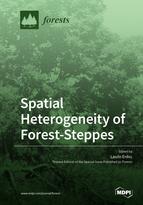Spatial Heterogeneity of Forest-Steppes
A special issue of Forests (ISSN 1999-4907). This special issue belongs to the section "Forest Ecology and Management".
Deadline for manuscript submissions: closed (25 November 2020) | Viewed by 24234
Special Issue Editor
Special Issue Information
Dear Colleagues,
Forming a transitional zone between the closed forest and the treeless steppe belts, forest-steppes are among the most complex non-tropical ecosystems. Forest-steppes have an extremely high spatial heterogeneity of both environmental factors and plant communities. The long-term co-existence of various forest, scrub, and grassland communities results in high taxonomic and functional diversities at both the local and the landscape scales. Moreover, forest-steppes host numerous taxa of special conservation interest, including a high number of rare, endangered, or endemic species.
Unfortunately, forest-steppes belong to the most threatened biomes on Earth. Vast forest-steppe areas, especially in Europe and West Asia, have been turned into croplands and tree-plantations, while surviving forest-steppe fragments are usually extremely small.
Despite its enormous conservation importance, spatial heterogeneity has received relatively little scientific attention in forest-steppe ecosystems. The aim of this Special Issue of Forests is to contribute to a better understanding of the key role spatial heterogeneity plays in maintaining the high alpha, beta, and gamma diversities of forest-steppe landscapes, and to help effective conservation measures to ensure the maintenance of this unique ecosystem.
Dr. Laszlo Erdos
Guest Editor
Manuscript Submission Information
Manuscripts should be submitted online at www.mdpi.com by registering and logging in to this website. Once you are registered, click here to go to the submission form. Manuscripts can be submitted until the deadline. All submissions that pass pre-check are peer-reviewed. Accepted papers will be published continuously in the journal (as soon as accepted) and will be listed together on the special issue website. Research articles, review articles as well as short communications are invited. For planned papers, a title and short abstract (about 100 words) can be sent to the Editorial Office for announcement on this website.
Submitted manuscripts should not have been published previously, nor be under consideration for publication elsewhere (except conference proceedings papers). All manuscripts are thoroughly refereed through a single-blind peer-review process. A guide for authors and other relevant information for submission of manuscripts is available on the Instructions for Authors page. Forests is an international peer-reviewed open access monthly journal published by MDPI.
Please visit the Instructions for Authors page before submitting a manuscript. The Article Processing Charge (APC) for publication in this open access journal is 2600 CHF (Swiss Francs). Submitted papers should be well formatted and use good English. Authors may use MDPI's English editing service prior to publication or during author revisions.
Keywords
- forest-grassland mosaics
- habitat complexity
- landscape heterogeneity
- semi-arid vegetation
- wooded steppe
- woodland






